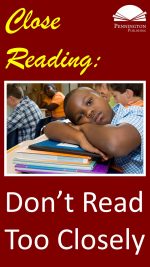Formalism and New Criticism
Reader-Response Theory attempts to describe the text-reader relationship and asserts that meaning is constructed outside this relationship from the input of both author and reader.
As a reaction to the Reader-Response Theory, beginning in the late 1960s, some reading researchers, philosophers, and especially university English professors began to advocate a different theory about the author-reader relationship that has come to be known as Formalism (or New Criticism). Proponents of Formalism argue that the author’s text should be read as is and in its own context apart from outside influences, such as the author’s background, motives, and biases and reader’s feelings, experiences, and interpretations. Many in this school of thought believe that the accurate meaning of the text may only be discovered if all subjective influences are ignored.
Many formalists especially rail against the more extreme views within the reader-response camp. They would argue that a reader-centered transaction permits the reader to make the text say anything that they want it to say. Far from the no right answer approach of some reading-response theorists, they would argue that there are right and wrong interpretations of the author’s text. After all, it is the author’s text, not the reader’s text. Teachers should ask, “What does the text mean here?” Not “What does the author mean here and why did she say this?” And certainly not “How does this text relate to your own life and make you feel?”
Other formalists, such as Cleanth Brooks, has argued that Reader-Response Theory and Formalism (New Criticism) complement one another. For instance, he stated, “If some of the New Critics have preferred to stress the writing rather than the writer, so have they given less stress to the reader—to the reader’s response to the work. Yet no one in his right mind could forget the reader. He is essential for ‘realizing’ any poem or novel. . .Reader response is certainly worth studying.” However, Brooks tempers his praise for the reader-response theory by noting its limitations, pointing out that, “to put meaning and valuation of a literary work at the mercy of any and every individual [reader] would reduce the study of literature to reader psychology and to the history of taste” (https://en.wikipedia.org/wiki/New_Criticism).
The Formalist Theory has gained traction in American schools since the advent of the Common Core State Standards. Even Mortimer Adler’s old close reading strategy
has regained popularity. For those of you not familiar with this approach, close reading it is a reading strategy which focuses on text-dependent reading and analysis.
*****
FREE DOWNLOAD TO ASSESS THE QUALITY OF PENNINGTON PUBLISHING RESOURCES: The SCRIP (Summarize, Connect, Re-think, Interpret, and Predict) Comprehension Strategies includes class posters, five lessons to introduce the strategies, and the SCRIP Comprehension Bookmarks.
Get the SCRIP Comprehension Strategies FREE Resource:
*****
The Science of Reading Intervention Program
The Science of Reading Intervention Program: Word Recognition includes explicit, scripted instruction and practice with the 5 Daily Google Slide Activities every reading intervention student needs: 1. Phonemic Awareness and Morphology 2. Blending, Segmenting, and Spelling 3. Sounds and Spellings (including handwriting) 4. Heart Words Practice 5. Sam and Friends Phonics Books (decodables). Plus, digital and printable sound wall cards and speech articulation songs. Print versions are available for all activities. First Half of the Year Program (55 minutes-per-day, 18 weeks)
The Science of Reading Intervention Program: Language Comprehension resources are designed for students who have completed the word recognition program or have demonstrated basic mastery of the alphabetic code and can read with some degree of fluency. The program features the 5 Weekly Language Comprehension Activities: 1. Background Knowledge Mentor Texts 2. Academic Language, Greek and Latin Morphology, Figures of Speech, Connotations, Multiple Meaning Words 3. Syntax in Reading 4. Reading Comprehension Strategies 5. Literacy Knowledge (Narrative and Expository). Second Half of the Year Program (30 minutes-per-day, 18 weeks)
The Science of Reading Intervention Program: Assessment-based Instruction provides diagnostically-based “second chance” instructional resources. The program includes 13 comprehensive assessments and matching instructional resources to fill in the yet-to-be-mastered gaps in phonemic awareness, alphabetic awareness, phonics, fluency (with YouTube modeled readings), Heart Words and Phonics Games, spelling patterns, grammar, usage, and mechanics, syllabication and morphology, executive function shills. Second Half of the Year Program (25 minutes-per-day, 18 weeks)
The Science of Reading Intervention Program BUNDLE includes all 3 program components for the comprehensive, state-of-the-art (and science) grades 4-adult full-year program. Scripted, easy-to-teach, no prep, no need for time-consuming (albeit valuable) LETRS training or O-G certification… Learn as you teach and get results NOW for your students. Print to speech with plenty of speech to print instructional components.
Get the Close Reading Narrative Worksheet FREE Resource:
![]()


